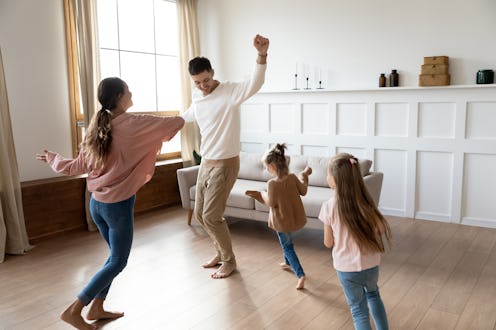Wellness
5 Socially Distanced Ways To Get Your Kids Excited About Moving
Staying active is more important than ever.

Social distancing may be the buzz phrase of the moment, but here's a phrase you may be less familiar with: sedentary lifestyle. It refers to people going through their days with little to no physical exercise. Ring any bells? In today's rush to abstain from potentially harmful activities, many of us (*raises hand*) have forgotten just how important it is to move.
And doctors are taking note. "Ordinarily, pre-COVID, people would on average be moving at least 2,000 to 3,000 steps per day, even with stationary jobs," Anita Juvvadi, MD, a pediatrician at Juvvadi Pediatrics of Stanford Children’s Health, tells Bustle. "But due to virtual classes and work from home schedules, everyone is moving less."
So what does that mean for our health? In addition to simply making us feel good, physical exercise can help with everything from immune support to reducing anxiety and depression. In an era full of unknowns, it's more crucial than ever to take full advantage of the benefits that getting active has to offer.
Bustle teamed up with Stanford Children's Health to talk with Dr. Juvvadi about her tips for keeping families healthy in the midst of the pandemic through fun — and socially distant — exercise ideas to get everyone up and running again.
1. Make A Plan
The first step to getting moving is figuring out how much exercise is enough exercise. "I usually recommend that children and adults get at least 30 minutes of active exercise, five days a week," Juvvadi explains. "On weekends, one hour of outdoor activity is a good goal."
Now comes the fun part — deciding how to spend your precious moments of movement. Get the whole family involved by planning activities like a backyard relay race or a bootcamp featuring pushups, squats, and crunches set to your kids' favorite music.
Once a plan is solidly in place, it'll generate excitement, not to mention keep people motivated and on track for success.
2. Set A Timer
With remote learning and WFH lifestyles, it can be easy to get caught up in what you're doing only to realize hours later that you missed your window for working out.
"For school-aged children and young teens, set a timer to remind them to take short breaks, like they would if they were physically in school," Juvvadi recommends. With just three 10-minute breaks per day (for example, before breakfast, before lunch, and before dinner), kids (and parents!) will easily hit the 30 minutes per day goal.
3. Get Outside
It's natural to want to avoid public spaces due to the current public health risks, but Juvvadi emphasizes the importance of finding ways to spend time being active outdoors.
"Make plans for weekend hikes or bike rides as a family," Juvvadi recommends. "Weekend trips offer kids the opportunity to learn about their surroundings, plus it gives the whole family something meaningful to look forward to during a long week."
Another massive benefit of leaving the house? Modeling safe, responsible behavior that may just quell some of your kids' anxieties.
"The more that families are staying indoors due to fears of exposure, the more children are getting paranoid and worried about getting sick if they step out," Juvvadi tells Bustle. "If parents take proper precautions and try to keep up with outdoor activities, it's likely that children will feel more safe."
4. Recruit Your Friends
Movement loves company. To up the fun and motivation factors, Juvvadi recommends forming an exercise "pact" with friends.
"Plan to run or walk a marathon in a month between two families, so each one can make the goal to cover 13 miles," she recommends. This type of communal goal setting will make you more likely to follow through, not to mention keeping kids engaged by adding some friendly competition to the process.
5. When In Doubt, Get Creative
Exercising doesn't have to mean running around the block or doing jumping jacks (although those are both great ways to get moving!). Finding creative ways to be active will keep your family on their toes.
Juvvadi recommends activities that serve double duty as a way to get moving, and a way to help someone else. Take a neighbor's dog for a walk if they're having a busy day, or help rake leaves for people with limited mobility — you'll get a workout in while also making someone's day.
And if you still feel like you've run out of exciting options, don't be afraid to go digital! Workout videos and apps are an easy (and often free!) way to keep your family engaged, challenged, and on the right track.
This post is sponsored by Stanford Children's Health.